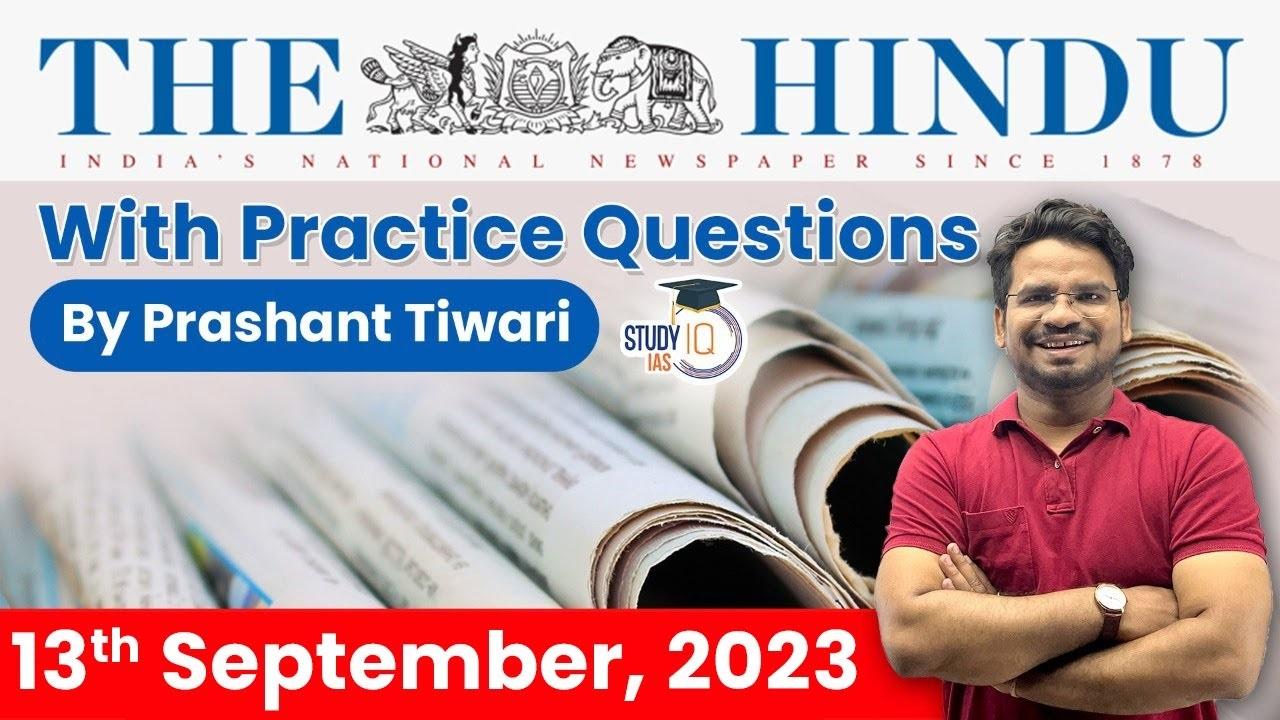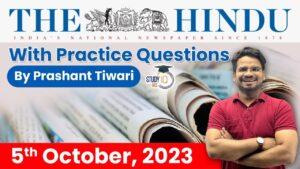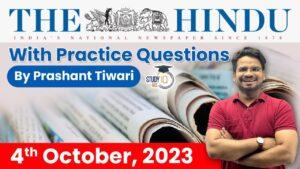The Hindu Newspaper Analysis for UPSC

The Hindu Newspaper Analysis 12 September 2023
- India’s retail inflation eased slightly to 6.83% in August, from the 15-month high of 7.44% in July, but the rise in food prices remained elevated at around 10% and rural consumers continued to face over 7% inflation.
- The year-on-year rise in vegetable prices, which had soared 37.4% in July, eased a little, but was still high at 26.1% last month. Inflation in cereals moderated marginally from around 13% in July to 11.85% in August but pulses prices rose 13% again, amid concerns about lower kharif sowing stoking them further in coming months.
- While a 5.8% sequential drop in vegetable prices from July contributed almost half the decline in August’s Consumer Price Index (CPI), a slight dip in the inflation rate for clothing, footwear, housing and miscellaneous items helped too.
- What is the Consumer Price Index?
- It measures price changes from the perspective of a retail buyer. It is released by the National Statistical Office (NSO).
- The CPI calculates the difference in the price of commodities and services such as food, medical care, education, electronics etc, which Indian consumers buy for use.
- The CPI has several sub-groups including food and beverages, fuel and light, housing and clothing, bedding and footwear.
- Four types of CPI are as follows:
- CPI for Industrial Workers (IW).
- CPI for Agricultural Labourer (AL).
- CPI for Rural Labourer (RL).
- CPI (Rural/Urban/Combined).
- Of these, the first three are compiled by the Labour Bureau in the Ministry of Labour and Employment. Fourth is compiled by the NSO in the Ministry of Statistics and Programme Implementation.
- Base Year for CPI is 2012.
- The Monetary Policy Committee (MPC) uses CPI data to control inflation. In April 2014, the Reserve Bank of India (RBI) had adopted the CPI as its key measure of inflation.
Q) Consider the following statements: (2020)
- The weightage of food in Consumer Price Index (CPI) is higher than that in Wholesale Price Index (WPI).
- The WPI does not capture changes in the prices of services, which CPI does.
- The Reserve Bank of India has now adopted WPI as its key measure of inflation and to decide on changing the key policy rates.
Which of the statements given above is/are correct?
- 1 and 2 only
- 2 only
- 3 only
- , 2 and 3

- The formation of a committee, helmed by a former President of India, Ram Nath Kovind, to determine how this might be implemented, and what manner of constitutional changes might be required to make it a legal reality, have generated further debate.
- The primary arguments in favour of simultaneous elections are twofold: first, that it will decrease the costs of conducting elections (and of electioneering); and second, that it will free up political parties from being in ‘permanent campaign mode’, and allow them to focus on governance (and, for that matter, constructive opposition) for a five-year period.
- if the concern, therefore, is that frequent State elections hamper governance and the business of Parliament, then simultaneous elections seem a needlessly complicated answer when a simple one is available: that State elections should be primarily fought by State party units, while national politicians can get on with the task of governance.
- The second, and graver concern, is the incompatibility of a rigid election timetable with some of the fundamentals of parliamentary democracy: as is well-known, at the time of Independence, central and State elections were conducted simultaneously.
- The first is that President’s Rule (i.e., central rule) will be imposed in that State until the five-year-period is over
- The second is that elections will be held in that State, but the term of the new Assembly will only be until the next cycle (which could be in a year, or three years, or four years).

- In Shreya Singhal v. Union of India (2015), the Supreme Court held Section 66A of the Information Technology Act as unconstitutional. It found the term “grossly offensive” in the Section to be vague and devoid of precision.
- A few omitted sections are unnatural offences (Section 377 of the Indian Penal Code), adultery (Section 497 of the IPC) and attempt to commit suicide (Section 309 of the IPC, though not completely).
- While the definition of ‘terrorist act’ in the Sanhita has been largely borrowed from the Unlawful Activities (Prevention) Act (UAPA) of 1967, the words ‘to strike terror in the people’ have been replaced with the words ‘to intimidate the general public’.
- Another offence reintroduced with some changes (in place of sedition) is about ‘acts endangering sovereignty, unity and integrity of India’. This appears more objective as it does not intend to punish criticism of or disaffection towards the government.

The Sedition Law in India:
- Section 124A of the IPC:
- It deals with Sedition – a non-bailable offence and was drafted by TB Macaulay and included in the IPC in 1870.
- Whoever (by words/signs/visible representation) brings or attempts to bring into hatred or contempt or excites or attempts to excite disaffection towards the Government established by law in India shall be punished.
- Punishment under Section 124A: Punishment under the law varies from imprisonment up to three years to a life term and fine.
- Need of Section 124A: To effectively combat anti-national, secessionist and terrorist elements.
- Criticism of Section 124A:
- It is designed to suppress the liberty of the citizens (Gandhiji).
- It is highly objectionable and the sooner we get rid of it, the better it is (Jawaharlal Nehru).
- Not in tune with the current social milieu, and was intended for a colonial regime.
- Often misused to muzzle dissent.
- Low conviction rate.

- Defence Minister Rajnath Singh on Tuesday virtually laid the foundation stone for the Nyoma airfield in eastern Ladakh near the Line of Actual Control (LAC) and also inaugurated the crucial Nechiphu tunnel on the axis to Tawang in Arunachal Pradesh.
- In all, he inaugurated 90 infrastructure projects built by the Border Roads Organisation (BRO) at a cost of over ₹2,900 crore, across 11 States and Union Territories, which include two revamped airfields in Bagdogra and Barrackpore in West Bengal, two helipads, 22 roads and 63 bridges.
- Of these 90 projects, 36 are in Arunachal Pradesh; 26 in Ladakh; 11 in Jammu & Kashmir; five in Mizoram; three in Himachal Pradesh; two each in Sikkim, Uttarakhand and West Bengal; and one each in Nagaland, Rajasthan and Andaman & Nicobar Islands, a Defence Ministry statement said.
- “The Nyoma airfield, to be developed at a cost of approximately ₹200 crore, will boost air infrastructure in Ladakh and augment the IAF’s capability along the northern border. The Defence Minister exuded confidence that the airfield, which will be one of the world’s highest, would prove to be a game-changer for the armed forces,” the statement said.




- Climate-linked warming is likely to weaken winter precipitation from the Western disturbance and shift it to more intense rain events. If this happens later into the summer, its consequences will be of great concern.
- The El Niño and other climate phenomena affect rainfed agriculture in many ways, from delaying the start of rains, and affecting sowing, to hot temperatures that may negatively influence plant growth and soil moisture.
- Our daily diet in India — from cooking oil to diverse foods — also requires 3,268 litres of water per person per day on average, subject to regional variability. Some 75% of this footprint is green water, demonstrating the importance of rainfed agriculture to our food and nutritional security.
- The amount of monsoon precipitation has been declining since the 1950s, attributed by some climate scientists to the reduction in land-sea thermal gradient due to warming of the seas.


 The Hindu Newspaper Analysis 6 October 2...
The Hindu Newspaper Analysis 6 October 2...
 The Hindu Newspaper Analysis 5 October 2...
The Hindu Newspaper Analysis 5 October 2...
 The Hindu Newspaper Analysis 4 October 2...
The Hindu Newspaper Analysis 4 October 2...



















